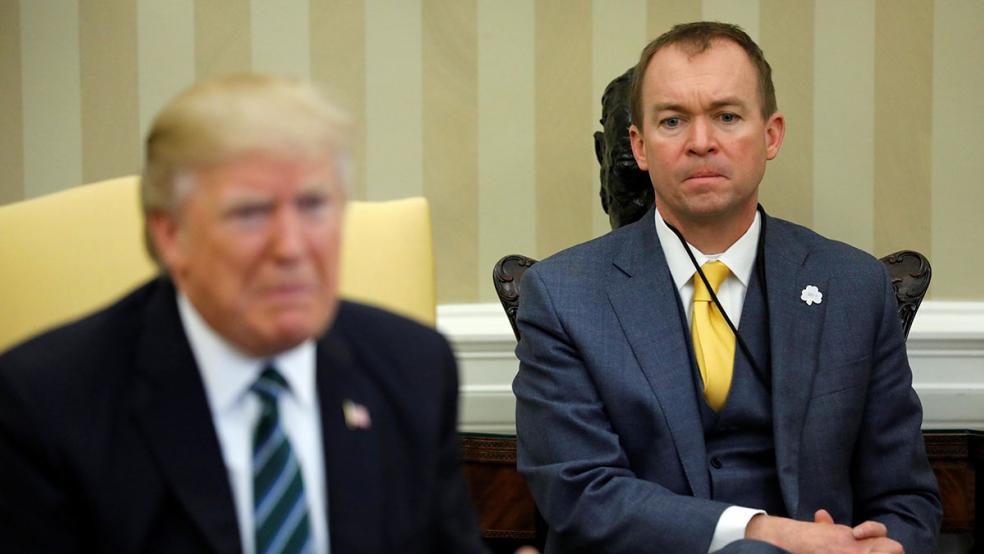When Donald Trump promised not touch Social Security and Medicare -- the two most expensive items on the federal budget -- but to go after waste, fraud, and abuse, it was obvious he would try to streamline the federal workforce to ensure that every job was necessary to meet the mission of each agency and program.
White House Budget Director Mick Mulvaney formally lifted President Trump’s 90-day federal hiring freeze on Wednesday, while mandating department and agency heads to begin thinking about ways to reorganize the federal bureaucracy to achieve billions of dollars in savings in the coming years.
Although the young Trump administration has yet to show an aptitude for strategic, long-term thinking – especially in Syria and the Middle East -- Mulvaney is promising to remold the federal workforce and start from scratch.
Related: Budget Chief Admits Trump Can’t Wipe Out $20 Trillion in Debt in 8 Years
“The executive branch of government has never been rebuilt,” he told reporters on Tuesday. “It has grown organically over the course of the last 240 years. The President of the United States has asked all of us in the executive branch to start from scratch. A literal blank piece of paper, and say, ‘If you were going to rebuild the executive branch, what would it look like?”
Mulvaney didn’t hazard a guess as to what a futuristic federal workforce would look like, exactly, other than to say it would be a big part of Trump’s call for “draining the swamp” and initially at least would mimic the spending priorities spelled out in the president’s recent budget submission to Congress for fiscal 2017 and 2018.
If that’s the case, then it’s a good bet a reconstituted bureaucracy would be top heavy with civilian workers at the Pentagon, the VA and Department of Homeland Security, which all got major spending boosts for the coming years. The Environment Protection Agency (EPA), the Department of Housing and Urban Development (HUD), the State Department and other agencies whose past policies ran afoul of Trump’s vision for America would most likely be scaled back.
Another concern is how Mulvaney’s efforts dovetail with those of Jared Kushner, Trump’s son-in-law and a former real estate and media executive who is heading up a new White House office of American Innovation in the West Wing. Kushner has assembled a team of strategic consultants and former business executives to generate fresh thinking in government and eliminate wasteful or duplicative programs.
Related: The Five Biggest Winners and Losers in Trump’s Fiscal 2018 Budget
Presumably, Mulvaney and Kushner are working in concert, yet the potential for overlapping efforts and tension are great. Moreover, there are numerous political and legal obstacles to any major overhaul and downsizing effort, as previous administrations have discovered.
Max Stier, an authority on the federal workforce, said in an interview that the Trump administration might be on the right track if they approach reforms as a way of re-aligning government services to the president’s policies, and not as an excuse for slashing the size of government.
“That’s the big question in my mind,” said Stier, president and CEO of the non-partisan Partnership for Public Service, a federal government advocacy group. “If the goal is to downsize, then it’s a mistake. If the goal is to align your human resources against your priorities and it as efficient as possible, then it’s hard to argue with. It’s the right thing to do, and ought to be done on a regular basis.”
All this activity stems from Trump’s Jan. 23 executive order imposing the temporary hiring freeze and calling for long-term planning to overhaul and downsize the federal government.
Related: Team Trump Wants to Sell Unused Federal Buildings, But it Won’t Be Easy
However, with the exception of substantial shrinkage during the Clinton administration, the size of the civilian workforce is around 2.8 million. Technological advancements should have replaced a vast number of clerical and administrative workers. In addition to its full-time workforce, the federal government paid close to $240 billion to its top 100 contractors in 2015.
Mulvaney was careful not to say yesterday how much lower the workforce number would go. He also had nothing to say about the mushrooming of private contract employees who constitute a shadow government of sorts, at a great cost to taxpayers.
The federal government is largely funded by Congress through annual appropriations bills, and lawmakers on key committees and subcommittees with jurisdiction over agencies and programs can block spending cuts and reorganization efforts they disagree with.
Republican and Democratic lawmakers including Senate Majority Leader Mitch McConnell (R-KY) and House Speaker Paul Ryan (R-WI) already have raised objections to some of Trump’s proposed spending cuts. And many Democratic lawmakers are likely to object to steep cutbacks in the ranks of federal workers – including many who are constituents.
Related: The Federal Government Really Does Need an Overhaul: Can Trump Get It Done?
Stier stressed that Congress would have a lot to say about the ultimate success or failure of the Trump workforce initiatives. “You can’t dance alone on this,” he said. “You’ve got to have Congress involved from the get-go. Not only do they make the budgets themselves and appropriate the money, but they also are fundamental to most consequential changes you might want to implement.”
Also, the new administration must cope with a maze of federal civil service rules that greatly complicate efforts to downsize agencies through a reduction in force (RIFs), firing and retirement.
Robert Shea, a former OMB executive during the administration of George W. Bush, told Federal News Radio that Mulvaney was undertaking a herculean effort to integrate all or part of 22 different federal departments and agencies.
“If they try to do that, they’ll fail,” said Shea, now a principal with Grant Thornton. “If they break it into manageable parts, it might not just be the most ambitious reorganization in the last 20 years or more; it could also be the most successful.”





